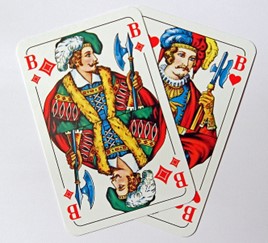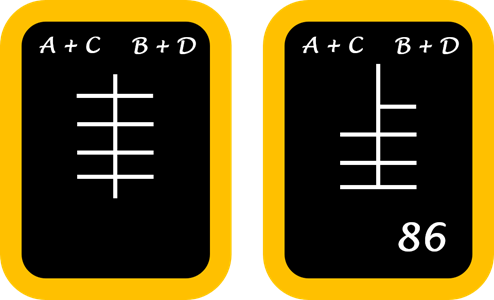Viersche / Hundert

A four-player partnership point-trick game from the Black Forest in Germany using a 36-card pack, in which the jack is the highest trump followed by the other jack of the same colour.
Class: Reunion Group
Related games: Hindersche
Region: Germany
Introduction
Viersche, also known as Hundert or Hunderte, is a little known card game that is local to the Wolf and Kinzig valleys in the Black Forest of Germany. It is a point-trick game for four players who play in two fixed partnerships of two, the target score being 100 points, hence the name Hundert(e) which is German for “one hundred”.
Hundert is first recorded on a 1932 map of the most common games played in Baden, republished in a 1951 article on Cego by Friedrich Schlager. At that time the centre of gravity of Hundert was in the area of the Wolf valley, but other locations appeared to be Oberharmersbach, a cluster of villages near Baiersbronn and others further south in the area St. Georgen, Villingen and Geisingen. During the 21st century Viersche tournaments began to be organised, usually around Epiphany (6th January), in the café and restaurant Zum Schlüssel in Bad Rippoldsau. They typically involved 36–40 players from the settlements of Bap Rippoldsau, Schapbach, Oberwolfach and Hausach.
Viersche is clearly the forward version of the reverse game of Hindersche which is played in much the same area. Both are dialect words, viersche meaning “forwards” and hindersche “backwards”. Which game came first is unclear, but it may be that Hundert was renamed Viersche when its reverse cousin was invented. According to Uwe Schoch, Hindersche was a game played by farmers, foresters and journeymen, and dates back at least 200 years to the Principality of Fürstenberg. However as far as is known, neither is recorded earlier than the 1930s. That said, the fact that play is anticlockwise and that the Tens are low suggest the game may well be two or three centuries old.
This article is based on information from Paul Eaton who carried out a field trip to the Black Forest in 2022, having been alerted by Sten Helmfrid to the existence of a local game called Viersche and by John McLeod to Schlager's references to the game Hundert. No rules were known for either Viersche or Hundert. In fact, they turned out to be the same game, a demonstration of which was given by Kurt Bonath and other local players in the Alte Tränke pub in Bad Rippoldsau on Thursday 15th September 2022. The players in the Alte Tränke preferred Hindersche because they felt it was more interesting with more options for tactical play. Nevertheless Viersche thrives locally with annual tournaments in Bad Rippoldsau and Oberharmersbach.
The playing cards depicted above are the jacks of diamonds and hearts from a Jass/Tapp pack, © ASS Altenburger. Pack design: Berlin or North German pattern, originally designed before 1856. Cards depicted by kind permission of ASS Altenburger.
Players, Cards and Objective
There are 4 players who play in two teams of two, the partners sitting opposite one another. The game is dealt and played anticlockwise
A 36-card, French-suited Jass/Tapp pack is used, but players found these hard to obtain (they are now out of production) and so usually shortened a standard 52-card pack, Berlin pattern pack by removing the 2s to 5s and any Jokers. Cards rank in their natural order, Aces high, and have the usual Ace-Ten values with two exceptions: the Jack of the trump suit, the Old Man (de Alt), is the highest trump; and the ‘next’ Jack (i.e. Jack of the same colour as the trump Jack), the Little Man (de Kloei), is the second highest trump. Both are worth 12 points. The ranking (from high to low) and the point values of the cards are as follows:
Trumps |
Non-trumps |
||
card |
points |
card |
points |
Jack |
12 |
Ace |
11 |
Next Jack |
12 |
King |
4 |
Ace |
11 |
Queen |
3 |
King |
4 |
Jack |
2 |
Queen |
3 |
Ten |
10 |
Ten |
10 |
Nine |
0 |
Nine |
0 |
Eight |
0 |
Eight |
0 |
Seven |
0 |
Seven |
0 |
Six |
0 |
Six |
0 |
|
|
A slate and chalk are used for recording scores and a small sponge or cleaning cloth for erasing marks.
The aim in Viersche is score at least 100 points in tricks, if necessary over two deals.
Deal
The first dealer can be chosen by any convenient method. The turn to deal passes to the right after each hand.
The dealer shuffles, offers the pack to the player on the left for cutting and deals 9 cards each in three packets of 3, beginning with forehand, the player to dealer's right. At the end of the deal, the bottom card of the pack, which belongs to the dealer, is turned face up. The suit of this card is trumps for the hand. It remains on the table while players look at and sort their hand, and is added to the dealer's hand when the first trick begins.
Rules of Play
Forehand, the player to dealer's right leads to the first trick and must lead a trump if possible. Lacking any trumps, forehand leads any card face down: this card counts as a trump for the purpose of following suit and cannot win the trick.
A player who holds a card of the led suit must either follow suit or play a trump. A player who is unable to follow suit may play any card - either a trump or a card of another suit. The trick is taken by the player who played the highest trump or, if no trumps were played, by the player who played the highest card of the led suit. The trick winner leads to the next trick and may lead any card.
Note. The Hindersche practice of 'schleipfen', which permits a player to pick up a trick that they have not won and lead to the next provided that the other players don't object, does not exist in Viersche.
Scoring

Left: starting scoreboard. A and C have the left hand side of the slate; B and D the right. Right: A and C won the first game and erased a rung; B and D are leading in the second game, having taken 86 card points in the first deal and needing just 14 more in the second, while A and C need 46.
At the start of a session, players chalk a ‘chicken ladder’ on the slate as shown. For clarity we use the terms deal, game, set and match to refer to the levels of scoring. A game may last for one or two deals, four games won make a set, and the first team that loses four sets loses the match.
Each team has 4 rungs on its side of the ladder and a ‘rung’ is erased for each game won. The object is to erase all four of your rungs, winning the set.
After all 9 tricks have been played, each team counts up the number of card points they have taken in tricks. The scores of the two teams should add up to 140 points.
The first team that scores a total of 100 or more card points wins one game and can erase a rung from their side of the slate. This may take one or two deals. If a second deal is needed, in principle the first team to reach 100 wins the game without the deal needing to be played to the end.
If neither side reaches 100 in a single deal, the number of card points scored by the leading team is written below the ladder on their side of the slate. The second deal is then played until one team correctly claims to have reached a total of 100. The leading team's target is the difference between the recorded score and 100, while the other team's target is the recorded score minus 40. [If the recorded score is x, then the trailing team begins the second deal with 140-x, and (140-x) + (x-40) = 100.]
A player may claim to have reached 100 immediately after their team wins a trick. The play of the hand is paused and the card points taken by the claiming team are counted. If the claim is correct the claiming team wins the game even if the other team already had enough points to win but had failed to claim: the winning team erases a rung, the number below the ladder is erased and in the next hand the teams begin again from zero. If the claim is false the play continues until a correct claim is made..
If a team takes all 9 tricks, they erase 2 rungs.
The first team to erase all four rungs wins the set and the losers chalk a mark on their side of the wooden frame of the slate. If a team manages to erase all four rungs before their opponents have erased any, the losers get two marks on the frame (two sets). The match ends once a team has 4 marks on the frame, representing the loss of four sets, and the other team wins the match. In tournaments there is an entry fee and there are prizes for the best players; a lost set is recorded as a Bolle, presumably a ‘blob’ on the scoresheet, and the overall losers becomes the ‘blob kings’ (Bollenkönige). In social circles they play for a drink or small stakes.
Conclusion
The origins of Viersche are unclear, but it seems likely to be a descendant of Réunion, a German game once popular in the Rhineland and along the River Neckar whose source lies close to the old border between Baden and Württemberg. Réunion is a point-trick game with the same card point scores as Viersche and in which the same two Jacks are promoted, although there are differences in the overall format. As described in the card game literature, Réunion is a three-player, non-partnership game using a 32-card pack in which Tens rank above Kings. There is no target score and there are 3 games in a rubber. Players must follow suit if able and otherwise must trump and there is a bonus for capturing the second highest trump with the highest.
Apart sharing from the name 100 and the face that both are partnership games using 36 cards, Viersche has no obvious connection with Hundertspiel, a descendant of Trappola which was formerly played in south Germany and Austria, and survived at least to the late 20th century in Romania as Stovkahra.
As a partnership game with a straightforward scoring scheme, Viersche is more sociable than Hindersche and easier to learn. The complexity of Hindersche is not in its rules of play, but in its arcane scoring system.